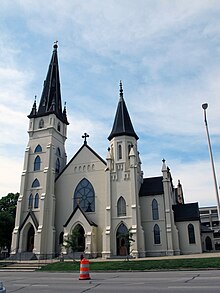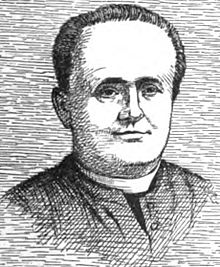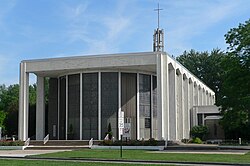|
Roman Catholic Diocese of Lincoln
The Diocese of Lincoln (Latin: Dioecesis Lincolnensis) is a Latin Church diocese in Nebraska, United States, and comprises the majority of the eastern and central portions of the state south of the Platte River. It is a suffragan see to the archdiocese of Omaha. The episcopal see is in Lincoln, Nebraska. The diocese was established in 1887, following the arrival of many Irish, German and Czech Catholic immigrants to the region. Starting in 2003, amid a widespread sexual abuse scandal in the Catholic Church, Lincoln was the only diocese in the United States to refuse to comply with the church's procedures for handling sexual abuse allegations. As of October 2024, Bishop James D. Conley is the current ordinary of the diocese. The Cathedral of the Risen Christ is the cathedral parish of the diocese. History1800 to 1862 The first Catholic missionary to visit Nebraska was Reverend Peter DeSmet, who crossed the Missouri River into Nebraska to baptize two infants of the Otoe people near present-day Bellevue in 1838. At that time, the area was under the jurisdiction of the Diocese of St. Louis. DeSmet later traveled along the Platte River to a council of the tribes.[1] Pope Pius IX in 1850 erected the Vicariate Apostolic of Indian Territory East of the Rocky Mountains. This huge jurisdiction contained the present-day states of Kansas, Nebraska, North and South Dakota, Colorado, Wyoming, and Montana.[2] The pope named Reverend John Miège from St. Louis as the vicar apostolic. Four years later, in 1854, the US Congress created the Nebraska Territory, a vast area covering six future states. The first Catholic church in Nebraska was St. Mary's, established in Omaha in 1856. In 1857, the Vatican suppressed the Vicariate of the Indian Territory, creating instead the Vicariate of Kansas, including all of Nebraska.[3] Miège was made vicar of the new vicariate. The second apostolic vicar of Nebraska was Reverend James O'Connor, appointed by Pius IX. 1862 to 1887In 1862, Reverend Emmanuel Hartig dedicated St. Benedict's Church in Nebraska City, the oldest standing church in the state.[1] During the American Civil War, Irish Catholic workers started immigrating to Nebraska to aid in the transportation of goods and to later build the Union Pacific railroad. Nebraska was admitted as a state in 1867.[1] By the 1870s, large numbers of German and Czech Catholic immigrants were settling on farms in the region. On August 2, 1885, the Vatican elevated the Apostolic Vicariate of Nebraska to the Diocese of Omaha.[4] 1887 to 1900 The Diocese of Lincoln was established on August 2, 1887, by Pope Leo XIII with territory taken from the Diocese of Omaha.[5] He appointed Reverend Thomas Bonacum of St. Louis as the first bishop of Lincoln.[6] When Bonacum became bishop in 1888, the diocese had a Catholic population of 23,000 with 32 priests, 29 parishes, and three parochial schools.[7] In 1888, Bonacum sued Patrick Egan, a prominent Lincoln citizen, for failing to pay a money pledge for St. Teresa's Pro-Cathedral.[8] It was rumored that Egan, a staunch Republican, reneged on the pledge because Bonacum had attended a Democratic Party reception.[9] The case went to the Nebraska Supreme Court, which ordered Egan to pay the pledge.[10] In 1891, Bonacum brought Reverend Martin Corbett of Palmyra before a diocesan court of five other priests.[11] The court dismissed the charges. Bonacum then tried to force Corbett to resign his position in 1894. Corbett refused and later sued Bonacum in civil court for libel.[9][12] The case was dismissed.[13] Bonacum became the first Catholic bishop in the United States to be sued in civil court.[9] A group of priests submitted a list of complaints against Bonacum to Francesco Satolli, the U.S. Apostolic Delegate, in 1893.[11] In retaliation, Bonacum tried in 1895 to expel one of those priests, William Murphy, from the diocese. Murphy had presided over the diocesan trial for Corbett two years earlier.[11] Murphy appealed to church authorities. In 1896, an ecclesiastical court of the Archdiocese of Dubuque reversed Bonacum's decision and ordered him to pay a fine as well as Murphy's legal fees.[11] Bonacum later excommunicated Murphy and in 1909 tried to physically evict him from his church in Ulysses. However, an angry group of parishioners chased Bonacum out of town. 1900 to 1957By the time of Bonacum's death in 1911, there was a Catholic population of 37,000 with 84 priests, 135 churches and 65 with resident pastors, and 28 parochial schools.[14] Later that year, Monsignor John Tihen of St. Louis was appointed the second bishop of Lincoln by Pope Pius X.[15] Four years later, Tihen was appointed bishop of the Diocese of Denver in 1917.[15] Bishop Charles O'Reilly from the Diocese of Baker City was named the third bishop of Lincoln in 1918 by Pope Benedict XV.[16] Early into his tenure at Lincoln, O'Reilly had to contend with the 1918 influenza pandemic, which claimed the lives of many priests and religious sisters.[17] He traveled to Rome in 1921 to recruit more priests, especially for the large Czech-speaking population in the diocese. During his five years as bishop, he established six new parochial schools and three new parishes.[17] After O'Reilly died in 1923, Pope Pius XI named Reverend Francis Beckman of the Archdiocese of Cincinnati as his replacement.[18] In 1930, Beckman was named archbishop of the Archdiocese of Dubuque. Pius XI then appointed Reverend Louis Kucera of Dubuque to be the next bishop of Lincoln. Kucera served as bishop for 27 years until his death in 1957.[19] Pope PIus XII appointed Auxiliary Bishop James Casey of Lincoln to succeed Kucera as bishop that same year.[20] 1957 to 2000During his nine-year-long tenure, Casey established a chancery building, a school for special needs children, a retreat house, several high schools and grade schools, and a Newman Center.[21] His most prominent accomplishment was the erection of the Cathedral of the Risen Christ in Lincoln; he broke ground on the new cathedral in June 1963 and dedicated it in August 1965.[22] The Southern Nebraska Register declared that Casey "accomplished more for the Diocese of Lincoln in 10 years than any other comparable period in our history."[21] Casey was appointed archbishop of the Archdiocese of Denver in 1967; Pope Paul VI then named Auxiliary Bishop Glennon Flavin of St. Louis to replace him in Lincoln. Flavin founded the School Sisters of Christ the King in 1976.[23] In 1981, Flavin prohibited women from serving as lectors during Mass; in response, Archbishop Rembert Weakland called his actions "a step backward and offensive."[24][25] Flavin retired in 1992 after 24 years as bishop of Lincoln. To replace Flavin, Pope John Paul II selected Monsignor Fabian Bruskewitz of the Archdiocese of Milwaukee in 1992.[26] In 1996, Bruskewitz issued a statement forbidding Catholics in the diocese to join a number of organizations, including the Society of St. Pius X, Call to Action, Planned Parenthood, Catholics for a Free Choice, the Hemlock Society, and various Masonic groups, under pain of excommunication.[27] In 1996, Bishop Fabian Bruskewitz established a task force to examine the idea of creating a seminary in the diocese. In 1998, St. Gregory the Great Seminary was opened.[28] 2000 to presentIn 2006, Bruskewitz rejected the proposed undertaking of an audit by the National Review Board of the United States Conference of Catholic Bishops. The audit would have examined whether the diocese had effectively implemented national guidelines on sexual abuse programs.[29] Bruskewitz retired in 2010. James D. Conley, formerly an auxiliary bishop from the Archdiocese of Denver, was appointed bishop by Pope Benedict XVI in 2012.[30][31] In June 2014, the chairman of the U.S. Conference of Catholic Bishops (USCCB) National Review Board for the Protection of Children reported that the Diocese of Lincoln was one of four American dioceses not in audit compliance. According to a 2015 statement by Conley, the diocese had complied with all church and civil laws on child abuse reporting and child protection; he stated that the audit process had been improved, and that the diocese would now participate in the USCCB audit. In 2016, Conley gave permission for lay married men to enter the permanent diaconate in cooperation with the archdiocese of Omaha's diaconate program.[32] In early 2019, Conley reiterated diocesan policy of only allowing male altar servers, making it one of two dioceses in the country with that restriction.[33][34] In May 2019, Reverend Charles Townsend was sentenced to 30 days in jail for providing alcohol to a 19-year-old in June 2017.[35] In December 2019, Conley announced that he was taking a medical leave of absence to treat depression, anxiety, insomnia, and tinnitus. Archbishop George Joseph Lucas was appointed to serve as apostolic administrator during Conley's leave of absence. Conley returned to active service in November 2020. In 2021, Matthew Hecker became the first permanent deacon to be ordained for the diocese.[36] As of 2023, Conley is the bishop of Lincoln. Sex AbuseIn April 2019, Archbishop Lucas released an investigative report on Monsignor Leonard Kalin, chaplain of the Newman Center at the University of Nebraska-Lincoln from 1970 to 1998. The report revealed that Kalin, removed in 1998, made sexual advances to seminarians. He also took them on out-of-state trips that involved gambling and heavy drinking.[37] In 2021, the Nebraska Attorney General report on sexual abuse by priests in Nebraska highlighted several instances in which Bishop Bruskewitz failed to follow canon law in handling allegations in the Diocese of Lincoln:
In October 2021, the diocese published a list of diocesan clergy with credible accusations of sexual abuse of minors.[40] The list included Copenhaver and Benton. Of 195 US bishops in 2003, Bruskewitz was the only one who refused to sign an official policy intended to prevent sexual abuse of children, called the Charter for the Protection of Children and Young People. He attributed sexual abuse by his priests to "homosexual perversion" and the consequences of society rejecting traditional Catholic teaching about marriage and birth control.[41] Demographics and statisticsStatistics as of 2021:
BishopsBishops of Lincoln
Diocesan priests who became bishops elsewhere
Schools
See also
References
External links |
||||||||||||||||||||||||||||||||||||||||||||||||||||||||||



